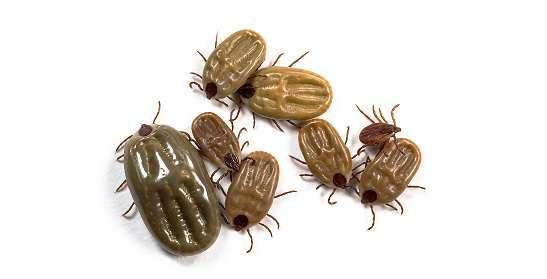When It's Not Lyme: Ehrlichia and Anaplasma, the Other Tick Diseases

- posted: Aug. 01, 2021
When It’s Not Lyme: the Other Tick Diseases
We all know Lyme disease is prevalent in York County and spread by deer ticks. But ticks can carry other diseases as well. Anaplasmosis and Ehrlichiosis are two other common tick-borne diseases in south central Pennsylvania that can affect our pets.
Ehrlichiosis is a bacterial infection spread by the brown dog tick or by the Lone Star tick. There are several species of Ehrlichia but the two that most commonly cause disease in dogs are E. canis (spread by dog ticks) and E. ewingii (spread by Lone Star ticks). Ehrlichiosis may cause lethargy, decreased appetite, fever and it may cause enlargement of the lymph nodes or spleen and low platelet counts which can cause bruising as it affects blood clotting. Ehrlichiosis can be treated with antibiotics though some dogs remain persistently infected. Ehrlichiosis is uncommon in cats and people and it does not pass directly from dog to dog or from a dog to a person or other animal. It is only transmitted by the bite of a tick.
Anaplasmosis is another bacterial infection spread by the bite of a deer or blacklegged tick—the same tick that carries Lyme. Many affected dogs do not show any symptoms of anaplasmosis but dogs may develop fever, lethargy and lameness similar to those seen in patients with Lyme disease and co-infection with Lyme is common. Golden and Labrador Retrievers are more commonly affected than other breeds, though any dog can be at risk. Anaplasmosis can also be treated with antibiotics and the prognosis is good. Anaplasmosis can also infect cats and humans as well as many other animals, but, like ehrlichiosis, it is only spread through a tick bite, not directly from dog to dog.
Unlike Lyme, there are no vaccines to protect pets against ehrlichiosis or anaplasmosis. These infections can be prevented by using a good flea and tick preventative and checking pets for ticks regularly, especially after visiting areas where ticks are prevalent. Removing ticks immediately can also reduce the chance of disease transmission as ticks often need to be attached for 12-48 hours to transmit disease. Simple blood tests can show if dogs are infected and treatment with antibiotics will usually clear infection though ehrlichia infections may be more serious than infection with anaplasma.
Contrary to popular belief, ticks can be active in all seasons—they do not hibernate in winter and will come out to search for a blood meal in temperatures as low as 35-40F. Keep pets protected against ticks year-round with appropriate chewable or topical flea and tick preventatives and help protect your dog from exposure to diseases like anaplasmosis and ehrlichiosis.
This blog brought to you by the Patton Veterinary Hospital serving Red Lion, York and the surrounding communities.
https://veterinarypartner.vin.com/default.aspx?pid=19239&id=4952341
https://veterinarypartner.vin.com/default.aspx?pid=19239&id=6191808
Location
Patton Veterinary Hospital
425 E Broadway
Red Lion, PA 17356
